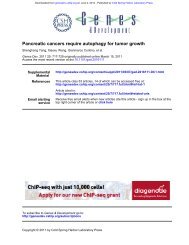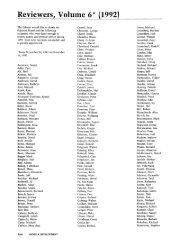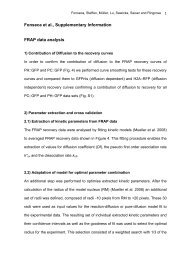I-Rel: a novel rei-related protein that inhibits NF-KB transcriptional ...
I-Rel: a novel rei-related protein that inhibits NF-KB transcriptional ...
I-Rel: a novel rei-related protein that inhibits NF-KB transcriptional ...
You also want an ePaper? Increase the reach of your titles
YUMPU automatically turns print PDFs into web optimized ePapers that Google loves.
Downloaded from<br />
genesdev.cshlp.org on December 18, 2012 - Published by Cold Spring Harbor Laboratory Press<br />
A CMVa-<strong>Rel</strong><br />
CIVlVp50/p65<br />
CMV/I-<strong>Rel</strong> -<br />
PMA<br />
-<br />
+<br />
flB<br />
B<br />
1|ig 2,Ltg 4].ig<br />
4- + + + CMV/I-<strong>Rel</strong><br />
1^ig<br />
+<br />
3^g<br />
+<br />
• •<br />
Exp. #1 Exp. #2<br />
-<br />
+<br />
CIVIVp50/p65 +<br />
l^ig<br />
+<br />
3^g<br />
+<br />
I-<strong>Rel</strong> <strong>inhibits</strong> <strong>NF</strong>-<strong>KB</strong> <strong>transcriptional</strong> activity<br />
D<br />
#f<br />
CMV/I-<strong>Rel</strong><br />
1^g 2|ag 4ng<br />
+ + +<br />
Figure 10. I-<strong>Rel</strong> is an inhibitor <strong>NF</strong>-<strong>KB</strong> m T lymphocytes. Jurkat T cells were cotransfected with a CAT reporter plasmid containing<br />
(the IL-2Ra regulatory sequence (nucleotides 421/-225) [A], or a plasmid with a synthetic sequence containing four copies of the <strong>KB</strong><br />
motif upstream of the SV40 promoter (H<strong>KB</strong>-4CAT; Leung and Nabcl 1988) and increasing amounts of CMV I-<strong>Rel</strong> {B). Cells were<br />
harvested 48 hr post-transfcction, and CAT assays were performed. (C) Cells were transfected with either the H<strong>KB</strong>4 reported plasmid<br />
alone or with CMV I-<strong>Rel</strong> and stimulated with PMA 30 hr after transfection. (D) Cells were transfected with plasmid pU3R-l (contains<br />
the HIV LTR driving expression of the CAT gene), plasmid pHTat (encodes the HIV trans-activator Tat), and CMV I-<strong>Rel</strong>. Cells were<br />
harvested at 40 hr post-transfcction for CAT assays. CAT assays shown represent a 30-min reaction. In each transfection, the amount<br />
of CMV promoter was kept constant to avoid spurious results reflecting competition for transcription factors.<br />
interact with each other, as exemplified by the association<br />
of p50 and p65 in <strong>NF</strong>-<strong>KB</strong> and y-rel with c-rel or p50<br />
(Simek and Rice 1988; Bacucrle and Baltimore 1989;<br />
Ghosh and Baltimore 1990; Lim ct al. 1990; Kerr et al.<br />
1991). On the basis of the findings reported here, we<br />
suggest <strong>that</strong> other /eZ-<strong>related</strong> <strong>protein</strong>s may form selective<br />
associations (i.e., each <strong>rei</strong>-<strong>related</strong> <strong>protein</strong> may only<br />
associate with a subset of <strong>rei</strong>-<strong>related</strong> <strong>protein</strong>s). Precedent<br />
for this possibility is provided by the selective interactions<br />
among the family of transcription factors <strong>that</strong> associate<br />
through a leucine zipper motif. For example, Fos<br />
forms heterodimers with lun-<strong>related</strong> <strong>protein</strong>s but does<br />
not form homodimers (Franza ct al. 1988; Rauscher et al.<br />
1988) and ATF-3 forms heterodimers with ATF-2 but not<br />
with ATF-1 (Hai et al. 1989).<br />
Whether the inability of I-<strong>Rel</strong> to associate with p65<br />
reflects subtle alterations between residues within a single<br />
multimerization domain or the presence of multiple<br />
dimerization domains with distinct specificities for individual<br />
<strong>rei</strong>-rclated <strong>protein</strong>s remains to be established.<br />
The ability of I-<strong>Rel</strong> to associate with p50 and not p65<br />
could be explained by either of the above possibilities.<br />
Similarly, we have recently described the identification<br />
of a naturally occurring variant form of p65 arising from<br />
an alternatively spliced p65 mRNA, designated p65A.<br />
p65A lacks the ability to form homodimers or associate<br />
with p50 but retains the ability to associate with p65<br />
(Narayanan et al. 1992; Ruben et al. 1992). The abihty of<br />
both I-<strong>Rel</strong> and p65A to establish selective associations<br />
with the individual <strong>rei</strong>-<strong>related</strong> family members would be<br />
consistent with the idea <strong>that</strong> subtle differences within<br />
the multimerization domains provide the opportunity<br />
for higher order regulation.<br />
I-<strong>Rel</strong> provides another example of a regulatory <strong>protein</strong><br />
<strong>that</strong> <strong>inhibits</strong> <strong>transcriptional</strong> activity through heterodimer<br />
formation with a <strong>related</strong> <strong>transcriptional</strong>ly active<br />
family member. For example, the <strong>protein</strong> Id lacks the<br />
basic residues adjacent to the FiLFi domain essential for<br />
specific DNA binding in the <strong>protein</strong> MyoD (Benezra et<br />
al. 1990). Id can associate with several <strong>transcriptional</strong>ly<br />
active HLH <strong>protein</strong>s, however, and attenuate their ability<br />
to bind DNA as a heterodimeric complex (Benezra et<br />
GENES & DEVELOPMENT 755







